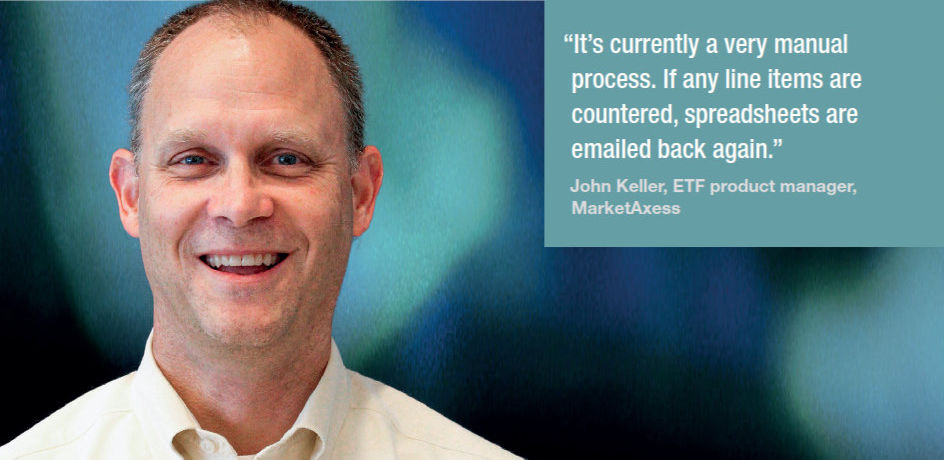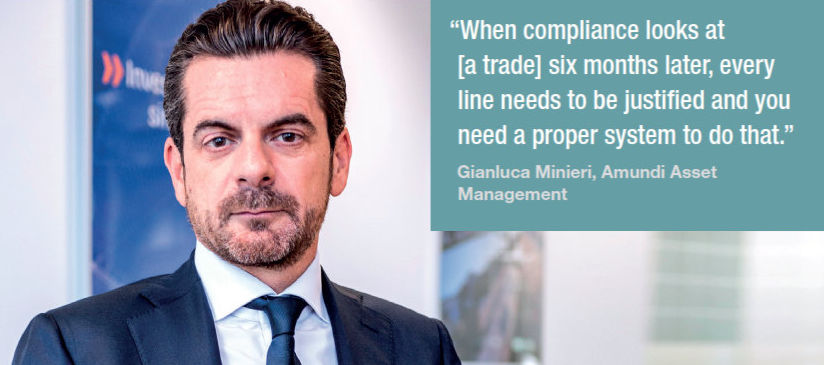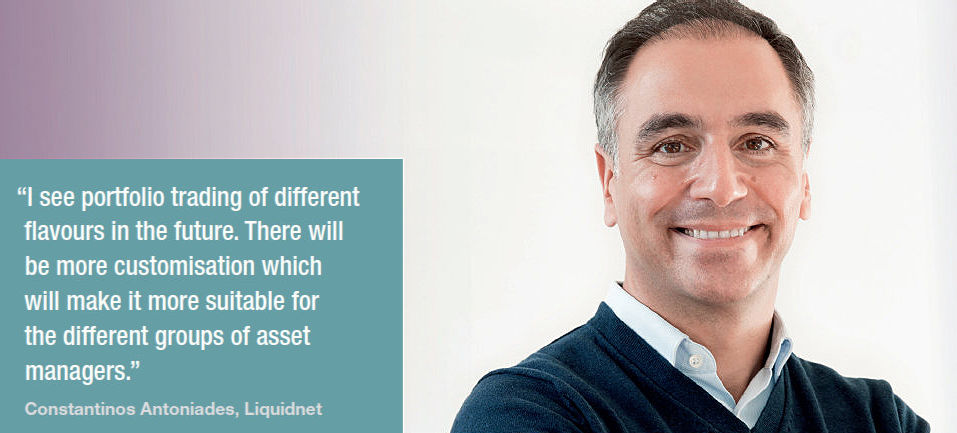Electronic portfolio trading offers an efficient execution channel for baskets of bonds, but Lynn Strongin Dodds finds there are several barriers to growth.
Portfolio trading is gaining traction in the corporate bond arena thanks to the supply of new electronic trading models and demand from exchange traded funds (ETFs). When executed correctly, a portfolio trade should improve pricing and speed, by filling an order for multiple securities simultaneously. That makes it particularly useful for index tracking funds which need to rebalance holdings as index components change, and firms that need to build a portfolio in a relatively short period of time and/or to optimise the liquidity in the market.
As regulation continues to bite, interest rates remain low and alpha is increasingly difficult to generate, asset managers are looking for greater trading efficiencies.
While trading a basket of securities has its advantages, conducting the trade manually has been an expensive and slow proposition because each individual chunk has to be priced.
 “It’s currently a very manual process,” says John Keller, ETF product manager at MarketAxess, where information is pasted from individual spreadsheets to a master spreadsheet with price and spread comparisons. “If any line items are countered, spreadsheets are emailed back again. This is not the most efficient process from a compliance and risk perspective.”
“It’s currently a very manual process,” says John Keller, ETF product manager at MarketAxess, where information is pasted from individual spreadsheets to a master spreadsheet with price and spread comparisons. “If any line items are countered, spreadsheets are emailed back again. This is not the most efficient process from a compliance and risk perspective.”
The burdensome process also makes it difficult to demonstrate best execution, according to Gianluca Minieri, deputy global head of trading at Amundi Asset Management.
 “When compliance looks at it six months later, every line needs to be justified and you need a proper system to do that,” he says.
“When compliance looks at it six months later, every line needs to be justified and you need a proper system to do that,” he says.
Interest in developing a more automated process has therefore been growing.
“There is a lack of liquidity due to the large number of venues, and we are seeing different providers come up with different solutions,” he says. “However, I do not see portfolio trading as additional or new liquidity but just another channel of liquidity being offered.”
Taking the other side of the trade
The game changer has been the burgeoning ETF bond market which facilitates the movement of large amounts of risk in a short period of time. Market participants are looking to leverage the redemption and creation process which offers both scale and liquidity, according to Robert Simnick, fixed income trader at Invesco. He explains portfolio trades move a basket of bonds into or out of the ETF itself and are usually paired with the acquisition or disposition of those securities by a market maker. The products are also increasingly being seen as reference prices for all index eligible corporate debt across the size and maturity spectrum.
 “It enables parties to transfer diversified corporate bond risk more quickly and efficiently than before,” says Simnick, adding that when prompted for a credit portfolio trade (CPT) quote, a dealer utilises new technologies to price the securities and can return a live, executable quote on the basket within about 30 minutes.
“It enables parties to transfer diversified corporate bond risk more quickly and efficiently than before,” says Simnick, adding that when prompted for a credit portfolio trade (CPT) quote, a dealer utilises new technologies to price the securities and can return a live, executable quote on the basket within about 30 minutes.
“A CPT trade basket can be shown to one dealer or multiple dealers, which puts them in competition with one another and allows the trader to select the best price,” he says. “The aim is to execute the list as a whole, and not to “cherry pick” the best and worst quotes on the bonds. The trader should engage in a portfolio trade that provides a lower overall execution cost than the traditional method of trading each security individually.”
The leading lights in developing portfolio trading solutions tend to be those with electronic trading platforms such as MarketAxess and Tradeweb or big fixed income ETF players such as Jane Street.
 “I see portfolio trading as a middle ground between the request-for-quote (RFQ) and high touch,” says Chris Bruner, head of US credit at Tradeweb, which launched its portfolio trading platform in January. “Portfolio transactions are dealer-to-client trades and the number of dealers providing pricing is smaller – 8 to 10 – versus an RFQ, where for example, there might be as many as 70 to 80 institutional dealers and hundreds of buyside responders across our platforms.”
“I see portfolio trading as a middle ground between the request-for-quote (RFQ) and high touch,” says Chris Bruner, head of US credit at Tradeweb, which launched its portfolio trading platform in January. “Portfolio transactions are dealer-to-client trades and the number of dealers providing pricing is smaller – 8 to 10 – versus an RFQ, where for example, there might be as many as 70 to 80 institutional dealers and hundreds of buyside responders across our platforms.”
MarketAxess is planning to follow suit in the autumn with a portfolio trading platform that will automate and streamline processes and enable clients to show their portfolios to more than one counterparty. They will also have access to market data and pricing analytics as well as straight through processing.
Barriers to progress
There are natural limits to increased adoption in a market that has tens of thousands of securities that are not in the indices.
Keller says, “There still has to be liquidity for the bulk of the underlying securities for the package to trade well,” he adds. “You can’t magically create liquidity when it is not there. However, I see portfolio trading increasingly being used for the more liquid bonds because finding it in the credit space is challenging.”
Finding the other side of a trade through electronic trading is still difficult in size. Figures from a recent Greenwich Associates Report – The Challenge of Trading Corporate Bonds – shows that e-trading in US credit still only accounts for a small percentage of overall daily trading. The consultancy’s data revealed that 70% of electronic trades executed are for 100 securities or fewer which is equivalent to US$100,000 or less. Over 90% of trades, by number, may be executed on electronic trading platforms, but that figure still only represents 3–4% of the overall value traded on an average day.
The data also found that smaller-sized trades dominate. The average size for an investment-grade corporate bond trade may be approaching the US$2 million mark, but Greenwich research published in January revealed that 82% of corporate bond investors found trades above US$15 million “very difficult” to execute electronically.
 This is why Lars Wiberg, VP, product management agency trading at global trading systems provider Itiviti, does not “see bonds ever being 100% electronic because unlike equities, many do not trade frequently and there is a real lack of data.” He adds that the number of bonds deemed liquid under MiFID are a fraction of the overall bonds that are traded. In its latest report in August, the European Securities and Market Authority (ESMA) put the number at 594.
This is why Lars Wiberg, VP, product management agency trading at global trading systems provider Itiviti, does not “see bonds ever being 100% electronic because unlike equities, many do not trade frequently and there is a real lack of data.” He adds that the number of bonds deemed liquid under MiFID are a fraction of the overall bonds that are traded. In its latest report in August, the European Securities and Market Authority (ESMA) put the number at 594.
“The technology, workflows and platforms are already in place but we have a long way to go before the market catches up,” he says. “Processes need to be standardised and a golden source of data created before that happens.”
Looking farther down the road, market participants expect the model will continue to evolve although it will not be for everyone.
“At the moment there are few providers but it is still early days and I think it will grow as the use of ETFs continues to increase,” says Stuart Campbell, head of trading at BlueBay Asset Management.
“However, I think it is more suited for passive funds,’ he adds “As an active manager, my concerns are over information leakage in that one house now knows my intentions / favoured positions and use this information against me should the basket not trade. It takes a leap of faith to show a large portfolio of bonds to one counterparty for pricing if the individual line items are above market size.”
 Others believe that there will be more segmentation as the service and functionality develops, “I see portfolio trading of different flavours in the future,” says Constantinos Antoniades, head of fixed income at Liquidnet, who is evaluating potential portfolio trading workflows to address some of the past shortcomings. “There will be more customisation which will make it more suitable for the different groups of asset managers.”
Others believe that there will be more segmentation as the service and functionality develops, “I see portfolio trading of different flavours in the future,” says Constantinos Antoniades, head of fixed income at Liquidnet, who is evaluating potential portfolio trading workflows to address some of the past shortcomings. “There will be more customisation which will make it more suitable for the different groups of asset managers.”
©The DESK 2019
©Markets Media Europe 2025












